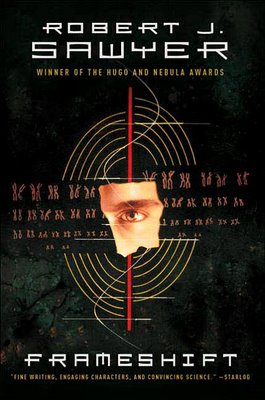Frameshift trade paperback 2nd printing

Woot! Just received from Tor a copy of the 2nd trade-paperback edition of my novel Frameshift.
Frameshift was originally published in hardcover in 1997. It was (a) my first-ever bookstore hardcover, and (b) my first title for Tor Books. It is also one of my personal favourites of my books. It had a good life in hardcover, a good life in mass-market paperback, and is now doing well in trade paperback, as this second printing attests.
Among other cool things, Frameshift was a Hugo Award finalist, won Japan's Seiun Award for best foreign novel of the year, is the book that got me on Rivera Live with Geraldo Rivera (to talk about the Human Genome Project), and was recently a "summer reading" pick in the journal Science.
The Robert J. Sawyer Web Site
Labels: Frameshift



2 Comments:
This is one of the things I've never figured out: why is the TPB printing so often the *last* version that gets published? In other words, wouldn't it make more sense to go hardcover, then TPB, then mass market? I would have thought that progression would make the most sense, since my understanding has always been that there is no typsetting difference between the harcover and the TPB - the only thing that changes is literally the binding.
By contrast, the HC/MMPB/TPB progression seems counterintuitive (and not just because of the work involved in typesetting): you go from the highest price to the lowest and then end up somewhere in the middle. Wouldn't it be preferable to pose the questions "let's see who is willing to buy the book at this price [ie HC]", then "let's see who is willing to buy the book at this lower price [ie TPB]", then "let's assume that the number of people willing to buy it at the lowest price of all is highest, hence that's the one we'll keep printing ad infinitum [ie MMPB]". But obviously I'm missing something...
The reason is simple: hardcovers and trade paperbacks are sent to bookstores on a returnable basis: if the bookstore doesn't sell a copy in either of those formats, it's returned to the publisher.
Mass-market paperbacks are sent out on a destroy-if-not-sold basis: if the bookstore doesn't sell a copy, it rips the cover off that copy and sends only the cover back to the publisher. When a book is selling briskly (when it's reasonably new), mass-market is economical -- but about half the copies printed of any mass-market title are ultimately destroyed by bookstores.
When a book is selling at a more stately rate (when it's older), the print runs are smaller, and, at smaller print runs, it's not economically feasible for the publisher to allow half of those copies to be destroyed, and yet it's also expensive to ship heavy books back to the publisher -- so orders are kept small ... more or less to just what the bookstore thinks it might actually sell.
Also, many publishers do their hardcovers and trade paperbacks on acid free paper (which will last a long time and won't yellow); few do their mass-market paperbacks that way (they are considered pretty much disposable read-once copies); the trade paperback can survive being shipped to and from the warehouse over a period of many months or years; a mass-market copy couldn't, even if it were returnable.
Also, the progression you suggest might cannibalize the hard cover market. People who want a physically larger, more durable format might simply wait for your stage two -- the trade paperback (on which the profits are smaller, and the royalties are lower -- 7.5% of cover for the author, instead of 10%), which, in your model, would be coming soon.
Also, the paperback edition of a book traditionally comes a year after the hardcover; people have proven willing to wait that long for the cheapest edition; to pump a trade-paperback into the market after the hardcover and before the mass-market edition, would delay the cheapest edition to the point that all the reviews and media coverage for the hardcover will be long since forgotten, and the reader's interest in acquiring that book may have waned.
Finally, you're right that typesetting costs have to be born when the book goes to mass-market but (a) they have to be borne at some point regardless of what sequence you publish the editions in, and (b) they're just not that much -- no one sets metal type anymore; it's all just reflowing the existing computerized file in Quark, InDesign, or PageMaker.
Cheers,
Rob
Post a Comment
Subscribe to Post Comments [Atom]
<< Home